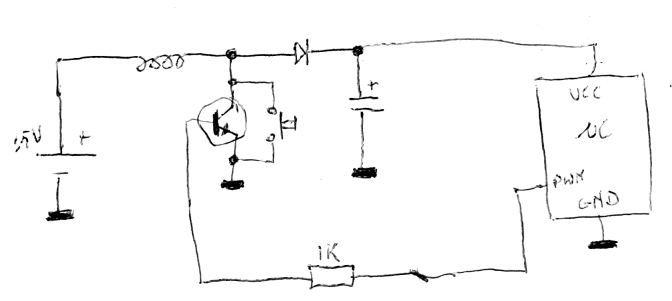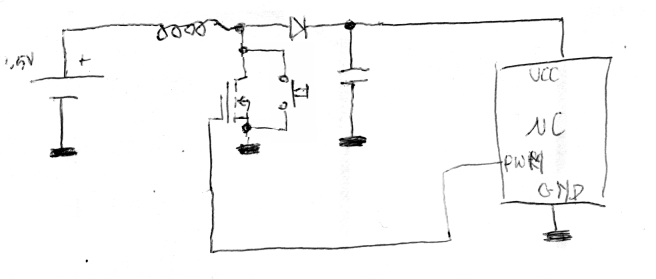Circuits
Here's the first circuit I built:

As you can see, this solution doesn't take many components to work. The
circuit is the same as the generic boost-circuit on the previous
page, with two differences: First of all, the controller is an actual uC
(I used an ATTiny13) powered from the power the DC/DC-converter generates, and
secondly there's a pushbutton in parallel with the transistor. Why the
pushbutton? As I said on the previous page: one of the problems with this
set-up is that you need a certain voltage to get the controller running, which'll
then generate power on its own so it will actualy keep running. I've
thought of many ways to generate this power: external PSU (defeats the purpose
of the project), using caps (works only from a certain voltage, if at all),
external oscillator (too much components) etc. Eventually, I arrived at this
crude but functioning solution: by pressing the button, you manually take over
the function of the transistor and build up a magnetic field in the coil. By
releasing it, the current the inductor generates should be enough to charge
the capacitor to a voltage which'll get the uC booting.
I decided to try the theory in practice. I programmed an ATTiny with code
to emit a fixed PWM-signal at one of its pins, built the schematics on a
breadboard and inserted a blue LED to show the circuit really works (blue LEDs,
like all LEDs, won't work with 1.5V; they need something higher.)
![]()
As you can see, the blue LED lights up nicely. I measured the power the
circuit emits and the power it drains from the AA-battery, and I calculated that
the circuit has an efficiency of about 69%. While it isn't the 90% you get with
a store-built dedicated boost-IC, it's not bad for some random code and parts
salvaged from old PCBs. I decided I could do better, though, so I modified the
switching part a bit:

The circuit now uses a MOSFET, which not only saves a part, but also increments
efficiency to 73 percent. While these figures aren't that impressive, the
MOSFET does mean we can now power more current-hungry applications. It does
have two downsides too: First of all, the mosfet I used has a gate voltage threshold
of 2V, which means the power generated from the bootstrapping procedure should be at
least that. Secondly: you need to specially pick your mosfet to have such a low
gate threshold voltage; for example, I couldn't get the circuit to bootstrap
using the widely used BUZ11, probably because it has a gate threshold of 4V